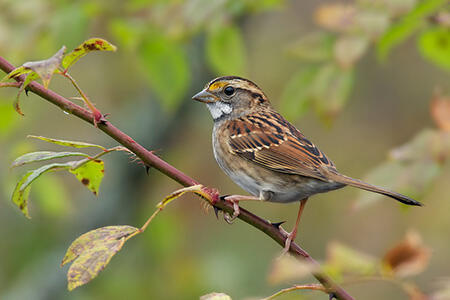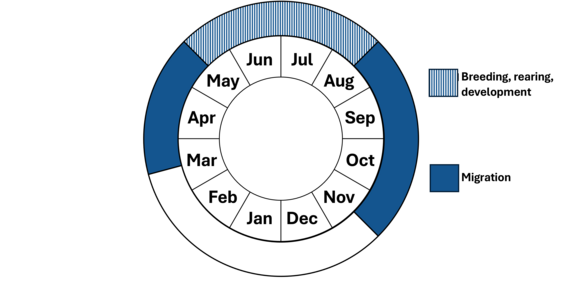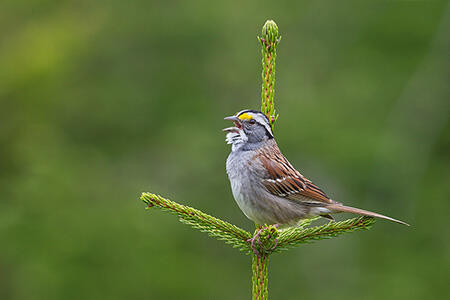- Scientific name: Zonotrichia albicollis
- Species of Greatest Conservation Need (MA State Wildlife Action Plan)
Description

The white-throated sparrow is a familiar songbird that breeds in coniferous forests throughout much of Canada, the Great Lakes region, New England and New York. A widespread migrant, this species is often encountered at feeding stations on its wintering grounds across the eastern United States, the desert southwest and the Pacific coast of California and Oregon. Known for its distinctive song, the white-throated sparrow also is unique for its dimorphism in both plumage and behavior. Within populations there are white-striped and tan-striped individuals that seek out the opposite morph as mates, resulting in the perpetuation of clearly dimorphic individuals.
Life cycle and behavior

White-throated sparrows are one of the most common and numerous spring migrants, with their peak migration occurring between mid-April and mid-May. They breed primarily in Canada and northern New England, but do have a limited breeding presence in Massachusetts, mainly in higher elevations of central and western regions like the Berkshires and Worcester County. These sparrows build their well-hidden nests on or near the ground, typically laying 3–6 eggs that hatch after an 11–14 day incubation period. General observations indicate that fledglings have been recorded in Worcester County in mid-late June, suggesting that nesting activities likely commence in late May or early June, with the breeding season extending through August. Typically, these sparrows raise a single brood per season, although they may renest if the first is unsuccessful.
Population status
In Massachusetts, the white-throated sparrow is not listed under the Massachusetts Endangered Species Act. However, it is designated as a Species of Greatest Conservation Need in the Massachusetts State Wildlife Action Plan due to habitat loss and population declines.
Distribution and abundance
In Massachusetts, white-throated sparrows are an uncommon breeder from Worcester County west and are considered rare and local breeders in the eastern part of the state. They are absent as breeders on Cape Cod and the Islands. They are generally found in the higher elevations of Worcester County and throughout the Berkshires.
Breeding Bird Survey data indicate that the population of the white-throated sparrow has experienced an overall decline of 0.7 percent annually from 1966-2022. The region of greatest decline is southern New England, with the individual states of Connecticut (4.5%) and Massachusetts (6.9%) showing the most dramatic downturns. Overall, populations have been shown to increase during spruce budworm outbreaks, and to decrease after especially cold winters.
Habitat

Breeding white-throated sparrows are found in coniferous and mixed forests, especially those with low, dense vegetation. They are particularly attracted to areas of second growth, such as beaver meadows, open bogs, forests affected by logging, fire, or insect damage, and areas of low, dense trees near the tree line. Nest sites are generally on or near the ground under dense vegetation along the edge of a clearing. In Massachusetts, white-throated sparrows are found in the coniferous and mixed forests of the western counties, and in the east, can occasionally be found breeding in red maple and white cedar swamps.
Healthy habitats are vital for supporting native wildlife and plants. Explore habitats and learn about conservation and restoration in Massachusetts.
Threats
The primary threat to white-throated sparrows in Massachusetts is loss of suitable breeding habitat due to development. Secondarily, the succession of breeding territories toward a more mature, closed canopy structure is a limiting factor in the amount of available breeding habitat. As Massachusetts represents the southern edge of the species breeding range, the state-wide breeding population is vulnerable to changes habitat due to warming temperatures caused by climate change.
White-throated sparrows have been shown to be particularly sensitive to the aerial spraying of fenitrothion over breeding territories, which can lead to both adult mortality and reduced reproductive success. High winter mortality during especially severe winters is also a contributing factor in local declines.
In primarily suitable forested landscapes, early successional forest patches should be included in rotational forest management where several small and several large early successional patches are rotated through the forest matrix. Where suitable habitat currently exists, efforts should be made to protect the landscape from development.
Predation by domestic cats has been identified as the largest source of mortality for wild birds in the United States with the number of estimated mortalities exceeding 2 billion annually. Cats are especially a threat to those species that nest on or near the ground.
An additional threat to the species is collisions with buildings and other structures, as approximately 1 billion birds in the United States are estimated to die annually from building collisions. A high percentage of these collisions occur during the migratory periods when birds fly long distances between their wintering and breeding grounds. Light pollution exacerbates this threat for nocturnal migrants as it can disrupt their navigational capabilities and lure them into urban areas, increasing the risk of collisions or exhaustion from circling lit structures or areas.
Conservation
The white-throated sparrow has experienced population declines, particularly in southern New England, due to habitat loss, forest fragmentation, and climate change. Conservation efforts should focus on protecting and restoring dense, shrubby understory habitats in both breeding and wintering areas. Forest management practices that preserve mixed woodlands with a healthy understory can support breeding populations, while maintaining early successional forests and reducing clear-cutting can provide crucial nesting sites.
Promote responsible pet ownership that supports wildlife and pet health by keeping cats indoors and encouraging others to follow guidelines found at fishwildlife.org.
Bird collision mortalities can be minimized by making glass more visible to birds. This includes using bird-safe glass in new construction and retrofitting existing glass (e.g., screens, window decals) to make it bird-friendly and reducing artificial lighting around buildings (e.g., Lights Out Programs, utilizing down shielding lights) that attract birds during their nocturnal migration.
References
Mass Audubon. "White-throated Sparrows." Accessed March 20, 2025. Mass Audubon.
Mass Audubon. "White-throated Sparrow Zonotrichia albicollis." Accessed March 20, 2025. Mass Audubon Breeding Bird Atlas 1.
Cornell Lab of Ornithology. "White-throated Sparrow Overview." Accessed March 20, 2025. All About Birds.
National Audubon Society. "White-throated Sparrow." Accessed March 20, 2025. Audubon Field Guide.
Horton, Brent M., et al. "Behavioral Characterization of a White-Throated Sparrow (Zonotrichia albicollis) Homozygous for the ZAL2m Chromosomal Rearrangement." Behavior Genetics 43, no. 1 (2013): 60-70.
Falls, J. Bruce, and James R. Kopachena. "White-throated Sparrow (Zonotrichia albicollis), version 2.0." Birds of the World (2020).
Sauer, J.R., J.E. Hines, J.E. Fallon, K.L. Pardieck, D.J. Ziolkowski, Jr., and W.A. Link. 2022. The North American Breeding Bird Survey, Results and Analysis 1966 - 2022. Version 01.30.2015 USGS Patuxent Wildlife Research Center, Laurel, MD.
Contact
| Date published: | May 16, 2025 |
|---|